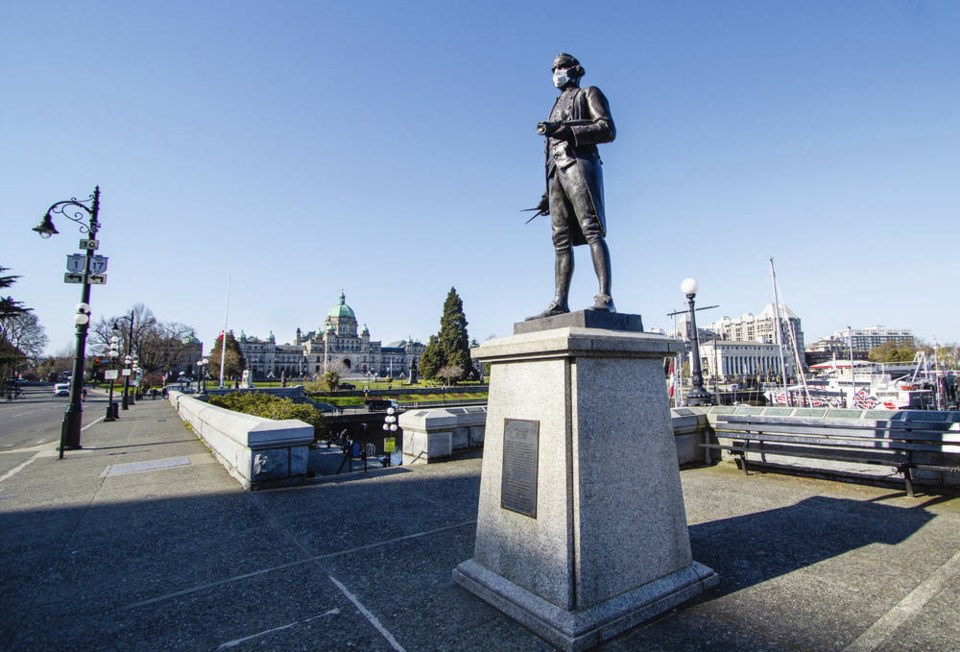The toppling of a statue of Capt. James Cook on Victoria’s upper causeway on Canada Day is bringing renewed focus to the role monuments play in teaching and shaping history.
The Cook statue was removed Thursday evening by a crowd that gathered on the legislature lawn before moving to the upper causeway. A rope was slipped around the statue’s neck, and it was pulled down and thrown into the water. In its place, the crowd placed a wooden red dress, a symbol representing murdered and missing Indigenous girls and women.
Some historians say the role of statues is to prompt stories from the past, while others say statues are not a history lesson but rather about commemorating or celebrating those depicted.
Kelly Black, a historian and executive director of Point Ellice House, said people can go to many places in Victoria to learn about the past, but statues are rarely a venue for educating.
“People are not learning about Capt. Cook from a statue. People aren’t learning about Joseph Trutch from a street name,” he said. “The idea that a statue will tell us something about the past is a bit misleading. It really only tells us about the values of the people who put up the statue.”
Black said tearing down statues is about building a different future and it’s time to have a serious conversation about what that future should look like in terms of truth and reconciliation. Within that context, decisions can be made about whether to remove or adapt statues, he said. “If we consider that Canada is a nation founded on the genocide of Indigenous peoples, and we want a future to be one where that won’t ever happen again, then that should tell us something about the people we’re choosing to commemorate from the past. And how we choose to commemorate them.”
Philip Steenkamp, president of Royal Roads University, said statues are not about recording history.
“They’re meant to shape our perceptions of history. And in particular, they’re put up usually by the rich and powerful in order to kind of reinforce their version of history and the existing order of the time. So the statue itself is not a history lesson,” he said. “It’s a way of celebrating, venerating or honouring someone.”
He noted people have been tearing down statues throughout history. Statues of pre-apartheid leaders in South Africa were torn down after the end of apartheid, monuments to former czars of Russia were removed during the Russian revolution and statues of Soviet leaders Vladimir Lenin and Joseph Stalin were toppled in Eastern Europe in the 1990s.
Statue removals tend to happen during revolutionary change, he said. “I do think we’ve reached that moment where people are prepared to kind of challenge these images and say, these images don’t represent my history or, you know, my vision of this country.”
He suggested the way forward is to engage a diverse group of people who represent the community to make decisions about an appropriate future for statues.
History professor John Lutz said statues by themselves don’t tell a story, but their role is to prompt people to tell stories about them, and they can provoke different stories.
The Capt. Cook statue can tell the story of the first European to make contact with Indigenous people on the coast, opening the door to colonization, Lutz said.
“There are many other stories that Capt. Cook statue tells. It tells a story of a humanitarian who when he met the First Nations on the northwest coast, treated them with kindness and dignity and was treated that way in return,” he said.
Lutz said the discovery of unmarked graves near three former residential schools in Canada struck people emotionally, but the toppling of a statue is the “least productive” way to redress historical harms.
“For a mob to take history into their own hands, and decide that their view of history is superior to everybody else’s, is, you know, inappropriate in a democracy,” he said.
The statue should be restored, and any decisions about its future should be made by officials, he said.
Police witnessed the scene Thursday evening but did not intervene or arrest anyone in the moment. Victoria police spokesman Bowen Osoko said officers’ primary duty is to keep people safe, and during the incident leaders of the group directed others to physically intervene if police stepped in.
At the same time, a group of 20 to 30 people broke off to march through downtown. They stopped outside a church and asked officers if they would intervene if they damaged the church, Osoko said.
“Officers did not know if the church was occupied, and given recent arson attacks on places of worship across Canada, and knowing that the statue was already being damaged, our focus remained on protecting people nearby and places of worship,” he said, noting while there were no arrests made, there were also no injuries.
Police are continuing to investigate and are aware of multiple suspects. Anyone with information about those responsible can call VicPD at 250-995-7654, extension 1.
A totem pole at the Malahat lookout that was set on fire apparently in retaliation for the statue’s removal has been surrounded by messages in chalk denouncing racism.



